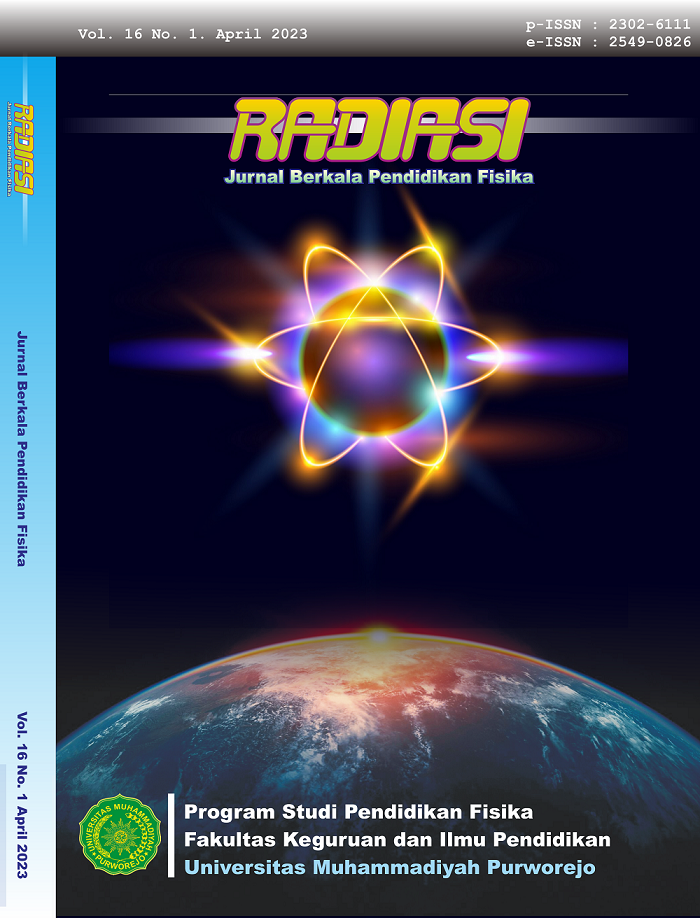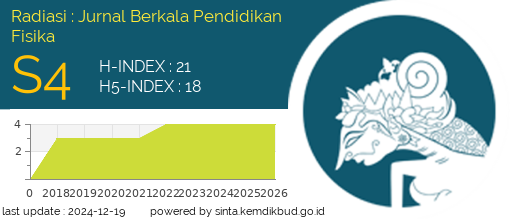Development of Phymol Integrated Media (Physics Mobile Learning) on Temperature and Heat in High School Physics Learning
Abstract
This study aims to develop learning media in the form of learning videos of Phymol (Physics Mobile Learning) Integrated Games on the material of Temperature and Heat. The research method used is the R&D (Research and Development) research method with the ADDIE development model, including the stages of Analysis (analysis), Design (design), Development (development), Implementation (implementation) and Evaluation (evaluation). In this study, the product was validated using an expert validation instrument which was distributed to two lecturers and three teachers and a limited trial was conducted using student response questionnaires. The results of product validation show an average percentage of 92% with a very feasible category. The limited trial conducted by the researcher involved 30 students of SMA Negeri 5 Cilegon. Student responses showed an average percentage of 86% with a very good category. Based on the results of expert validation and student response questionnaires, physics learning media in the form of Phymol learning videos (Physics Mobile Learning) integrated Games on Temperature and Heat material is very feasible and can be used as a physics learning medium.
Downloads
References
L. Bao dan K. Koenig, “Physics education research for 21 st century learning,” Discip. Interdiscip. Sci. Educ. Res., vol. 1, no. 1, hlm. 1–12, 2019.
I. A. D. Astuti, D. Dasmo, dan R. A. Sumarni, “Pengembangan media pembelajaran berbasis android dengan menggunakan aplikasi Appypie di SMK Bina Mandiri Depok,” J. Pengabdi. Kpd. Masy., vol. 24, no. 2, hlm. 695–701, 2018.
A. Ramdani, A. W. Jufri, dan J. Jamaluddin, “Pengembangan Media Pembelajaran Berbasis Android pada Masa Pandemi Covid-19 untuk Meningkatkan Literasi Sains Peserta Didik,” J. Kependidikan J. Has. Penelit. Dan Kaji. Kepustakaan Bid. Pendidik. Pengajaran Dan Pembelajaran, vol. 6, no. 3, hlm. 433–440, 2020.
E. Ismanto, M. Novalia, dan P. B. Herlandy, “Pemanfaatan smartphone android sebagai media pembelajaran bagi guru SMA Negeri 2 kota Pekanbaru,” J. Pengabdi. Untukmu Negeri, vol. 1, no. 1, hlm. 42–47, 2017.
A. Kitchenham, “Models for interdisciplinary mobile learning,” Unated State Am. Inf. Sci. Ref., 2011.
A. A. Ardiansyah dan N. Nana, “Peran Mobile Learning sebagai Inovasi dalam Meningkatkan Hasil Belajar Siswa pada Pembelajaran di Sekolah,” Indones. J. Educ. Res. Rev., vol. 3, no. 1, hlm. 47–56, 2020.
M. Á. González dkk., “Teaching and learning physics with smartphones,” dalam Blended Learning: Concepts, Methodologies, Tools, and Applications, IGI Global, 2017, hlm. 866–885.
B. E. Dasilva dkk., “Development of android-based interactive physics mobile learning media (IPMLM) with scaffolding learning approach to improve HOTS of high school students in Indonesia,” J. Educ. Gift. Young Sci., vol. 7, no. 3, hlm. 659–681, 2019.
T. Cerratto-Pargman dan M. Milrad, “Beyond innovation in mobile learning: towards sustainability in schools,” dalam Mobile Learning, Routledge, 2015, hlm. 154–178.
A. H. Ngurahrai, S. D. Fatmaryanti, dan N. Nurhidayati, “Pengembangan Media Pembelajaran Fisika Berbasis Mobile Learning Untuk Meningkatkan Kemampuan Berpikir Kritis Peserta Didik,” Radiasi J. Berk. Pendidik. Fis., vol. 12, no. 2, hlm. 76–83, 2019.
J. McDougall, M. Readman, dan P. Wilkinson, “The uses of (digital) literacy,” Learn. Media Technol., vol. 43, no. 3, hlm. 263–279, 2018.
D. Novisya dan D. Desnita, “Analisis Pengembangan Video Pembelajaran Fisika Berbasis CTL pada Materi Fluida,” JIPI J. IPA Pembelajaran IPA, vol. 4, no. 2, hlm. 141–154, 2020.
B. Saputro, Manajemen penelitian pengembangan (research & development) bagi penyusun tesis dan disertasi. Aswaja Presindo, 2017.
Sugiyono, Metode penelitian pendidikan:(pendekatan kuantitatif, kualitatif dan R & D), 2010 ed. Bandung: Alfa Beta.
A. M. Ariyanti, Z. Zainuddin, dan D. Dewantara, “Development of Electronic Teaching Material Containing South Kalimantan’s Traditional Game to Improving Students’ Problem-Solving Ability,” Radiasi J. Berk. Pendidik. Fis., vol. 15, no. 2, hlm. 60–71, 2022.
M. Rahayu dan H. Kuswanto, “Development of android-based comics integrated with scientific approach in physics learning,” dipresentasikan pada Journal of Physics: Conference Series, IOP Publishing, 2020, hlm. 012040.
Copyright (c) 2023 Aulia Ahadillailah, Andri Suherman, Asep Saefullah

This work is licensed under a Creative Commons Attribution-NonCommercial 4.0 International License.




